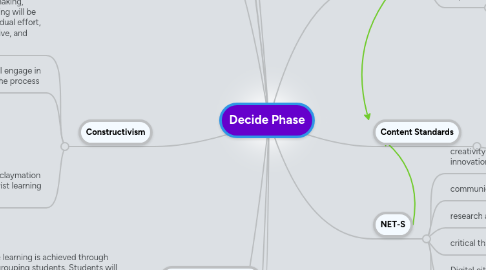
1. Learning Goals
1.1. What will students be able to do?
1.1.1. students will be able to design and produce a basic multi media production that demonstrates and explains the different phases of cellular reproduction
1.2. What will students know?
1.2.1. students will be able to identify and examine how interactions among the different molecules in the cell causes distinct stages of the cell cycle which can also be influenced by other signaling molecules
1.2.2. students will also be able explain the role of mitosis in the formation of new cells and its importance in maintaining chromosome number during asexual reproduction
1.2.3. students will learn how to navigate and search for information on the web, as well as becoming familiar with its capabilities
1.2.4. students will understand how mutation can affect cellular reproduction through mutation
2. Constructivism
2.1. constructivist thinking, decision-making, problem-solving, and critical thinking will be achieved through group and individual effort, claymation (manipulative, interactive, and physical materials)
2.2. students and instructor will engage in conversation throughout the process
2.3. through the use of the Internet and claymation five component parts or constructivist learning will be fulfilled
2.3.1. active: physically have to construct the different phases of cellular reproduction
2.3.2. cumulative: will build on prior knowledge of cells
2.3.3. reflective: students will have to assess what they know and what they need to learn
2.3.4. goal-directed: learners engage in purposeful learning activities (understanding the importance of cellular reproduction and how it affects each one of us through real-life experiences)
3. Bloom's Digital Taxonomy
3.1. student cognitive skills be challenged by searching for information in relation to the different self (raisins???)
3.2. attitudes will be built through group work that builds confidence for intercommunication, as well as independent thought
3.3. manual or physical skills will be stimulated through the hands-on activity of claymation and its visual reinforcement.
3.4. Remembering
3.4.1. Recognizing, Describing, Identifying, Retrieving, Naming, Locating, Searching, Googling
3.5. Understanding
3.5.1. Blog Journaling
3.5.2. Organizing and Classifying, Boolean Search
3.6. Applying
3.6.1. Carrying out, Operating, Uploading, Sharing, Editing, Using
3.7. Analyzing
3.7.1. Organizing, Structuring, Linking, Validating
3.8. Evaluating
3.8.1. Critiquing,Commenting, Collaborating, Reflecting
3.9. Creating
3.9.1. Designing, Planning, Producing, Filming, Blogging, Remixing, Directing/Producing
4. Multiple Intelligence
4.1. Verbal/Linguistic
4.1.1. Students will use written and verbal language skills when creating the claymation videos
4.2. Visual/Spatial
4.2.1. Students will use visual skills when creating their video productions and also when evaluating their peers
4.3. Musical
4.3.1. When multimedia presentation are developed students will use audio to enhance their productions
4.4. Interpersonal
4.4.1. Students will work in collaborative groups and also present their final projects to the class. Class discussion will also promote this type of intelligence.
4.5. Intrapersonal
4.5.1. Students will keep blogging journals of their project work and also self assess at the end of the unit.
4.6. Naturalist
4.6.1. New node
4.7. Existentialist
4.7.1. New node
5. Collaborative Learning
5.1. collaborative learning is achieved through pairing and grouping students. Students will search out the required information, research and then determine how best to apply what they have learned to developing their project
6. Student's Prerequisite Skills
6.1. students will require basic computer skills
6.1.1. know how to navigate the glogster
6.1.2. take digital pictures and upload them
6.1.3. create voice media
6.1.4. create text media
7. How will we monitor and assess student work?
7.1. the instructor will monitor and assess students through observation, periodic checks of group work as well as group discussion
8. How will multimedia enhance the learning process?
8.1. through the use of technology that is required for success in the 21st century
8.2. by helping to stimulate critical thinking
8.3. by providing an outlet for multiple intelligences
9. Focus
9.1. Grade
9.1.1. 9th Grade
9.2. Content
9.2.1. Phases of meiosis and mitosis
9.3. Topic
9.3.1. Cellular Reproduction, investigation of X-men mutants. Identify, where, and how, do you think their mutations occur in the phases of cell reproduction. If you were an X-men what would your mutation be? Identify, where and how do you think this mutation would be created in the process of cellular reproduction. I'm sure we can refine this, What do you think?
10. Content Standards
10.1. PA standards 3.1. BA 4, summarizing the stages of the cell cycle
11. NET-S
11.1. creativity and innovation
11.1.1. New node
